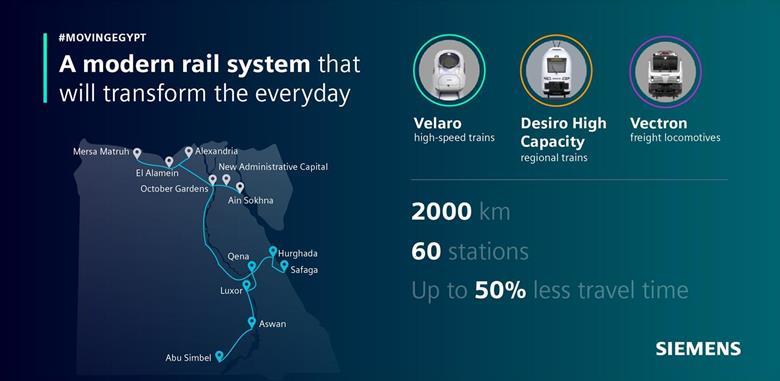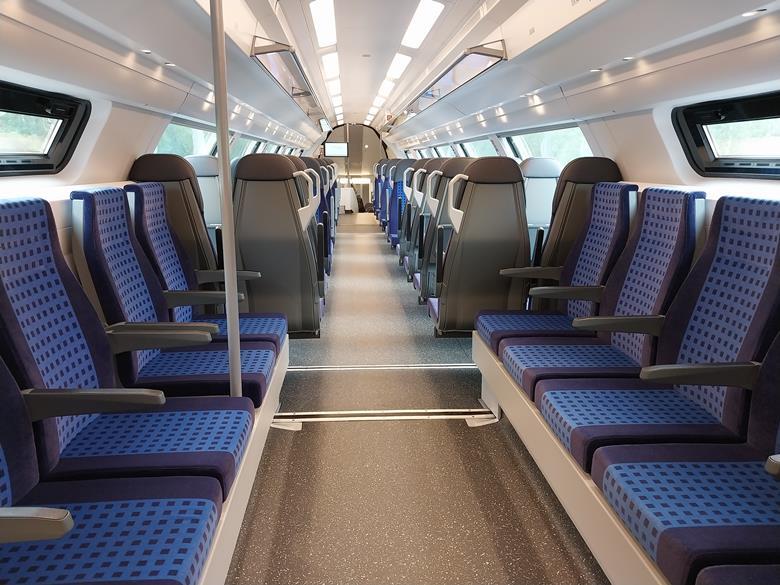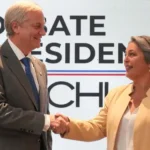
Siemens Mobility presented one of the 94 Desiro HC electric multiple units it is supplying to Egypt to international press at its Wegberg-Wildenrath Test and Validation Center on May 8.
A consortium of Siemens, Orascom Construction and The Arab Contractors was awarded a turnkey contract in May 2022 to develop a ‘Suez Canal on Rail’ network. This includes design, construction, commissioning and 15 years of maintenance of three electrified lines totaling 2,000 km. Designed for 250 km/h operations, these routes are also expected to carry regional passenger trains and freight traffic.
Siemens Mobility is supplying 41 eight-car Velaro train sets to operate the high-speed services, plus 94 four-car 160km/h Desiro HC regional EMUs for conventional stopping services and 41 Vectron electric locomotives to pull shuttle services. charge.
The Desiro HC EMU is based on the design in use since 2018 on the Rhein-Ruhr Express network in Germany. Egyptian EMUs are being built to be desert-proof.
Five of the Desiro HC EMUs have already been completed, and the first was delivered to the port of Alexandria last September.
The first set of Velaro high-speed trains is planned to be delivered at the end of this year.
Speaking to Railway Gazette International at the launch event, Peter Papert, director of the High Speed Rail Project consortium at Siemens Mobility Egypt, said that two of the high speed rail lines are currently under construction, totaling 1,760 km.
The 660km Green Line is being built between Mersa Matruh on the Libyan border and Ain Sokhna on the Red Sea via Alexandria and Cairo, while the 1,100km Blue Line is being built between Cairo and Abu Simbel near the border with Sudan, closely following the Nile River.
A third line is planned to run 225 km to connect Luxor with Hurghada and Safaga on the Red Sea.
‘Work is ongoing in the Cairo area, heading towards the Red Sea and the Mediterranean Sea, and along the Nile. The priority is to complete the sections around Cairo with special attention to the line to Alexandria, with which we can cover a population of 26 million alone,’ said Papert.
Civil works on the Green Line are ‘well advanced,’ while on the Blue Line, construction is underway on about 40% to 50% of the future alignment, according to Papert.
‘One of the most challenging parts of the work is building three bridges over the Nile River, two on the Blue Line and one on the Green Line,’ said Papert. The largest hub will be the New Administrative Capital station, which will offer interchange between the future high-speed rail network and various light rail, metro and monorail routes.
Siemens’ share in the contract is €8.1 billion. In addition to the supply of rolling stock, it also includes work on the rail system, including the delivery of electrification systems, ETCS Level 2 and the manufacturer’s Railigent asset management tool. Siemens is also responsible for overall project management, consortium leadership and delivery of an automatic fare collection platform.

The new network will be operated independently of Egyptian National Railways’ existing main lines. The operator of the new routes will be responsible for providing high-speed passenger services and conventional stops, which will operate during the day, as well as freight services, which will operate mainly at night.
Papert said that while operating contracts for the entire network still need to be finalized, it is ‘very likely’ that the remaining sections will be managed by Deutsche Bahn International Operations and a local partner. In November 2022, DB IO and Elsewedy Electric were awarded a 15-year contract to operate and maintain the Green Line.
By Railway Gazette International, May 9, 2024
Source: https://www.ocafezinho.com/2024/05/09/egito-esta-cruzando-o-pais-com-trens-de-alta-velocidade/

